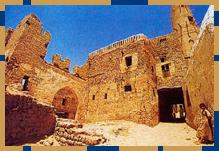Oases
| Dakhla
- The Oasis in the Old Kingdom |
The
old track between Farafra and Dakhla, the Darb el-Farafra,
ran across an area of the desert covered by sand dunes, where
driving a motor vehicle is extremely difficult. The modern
road runs west of the old route and, if coming from north,
offers an amazing view of the descent from the plateau into
the depression of Dakhla.
Like
other oases, there is evidence that Dakhla was inhabited since
prehistory, but unlike all the others, here significant remains
dating to the Old Kingdom have been found. The archaeological
remains unearthed at 'Ayn Asil in the last twenty years suggest
that this oasis must have played an important role under the
VI Dynasty of the Egyptian kings. Placed at the junction between
the track called Darb el-Tawil, leading directly to Middle
Egypt, and the two caravan routes which via Kharga gave access
to a number of tracks to Upper Egypt, 'Ayn Asil was originally
a small square fortified enclosure. During the reign of Pepi
II, the Governors of the oasis built a large palace and obtained
the permission to erect small sanctuaries for themselves.
 |
The
palace was eventually destroyed by the fire, the destructive
power of which has, however, helped to reconstruct some important
details of the building. The floor, in fact, retained the
impression of the wooden elements, such as doors or columns,
that collapsed and burned on the spot. The site was abandoned
after the fire, but later re-occupied during the First Intermediate
Period, where a certain amount of restoration seems to have
taken place.
Today,
the exposed area of the palace is quite striking. Even though
over 4,000 years have passed since it was built, the thick
mud-brick walls, clay floors and limestone column bases still
give a very good impression of what the building must have
looked like. Attached to the settlement, there was a large
necropolis, today called Qila el-Dabba, clearly marked by
the presence of seven large mastabas, massive rectangular
mud-brick superstructures that covered the tombs of the local
Governors.
|

|
Several
ancient cemeteries have been found in Dakhla, and it is evident
that the area was occupied continuously up to the Roman rule,
when the Oasis seems to have been heavily populated and intensely
cultivated. Hundreds of Roman wells still survive. The most
impressive remains of this period are to be found at Amheida,
a large settlement half-covered by sand surrounded by an extensive
necropolis.
Dakhla
was originally linked with Kharga by means of two tracks,
the Darb 'Ayn Amur and the Darb el-Ghubbari. The first was
shorter and provided with an intermediate water station, the
little oasis of 'Ayn Amur, but more difficult, since it climbed
the plateau dividing the two oases, while the second was longer
and without water, but easier for heavy-loaded caravans. The
modern road follows more or less the direction of this track,
and in fact groups of graffiti and rock inscriptions left
by travellers of various periods may be seen on both sides
of it. The area along this road is undergoing a significant
change. Phosphate is being mined out of the northern plateau,
and large settlements have been built to accommodate the people
working there and their families.
(Corinna
Rossi)
|
|